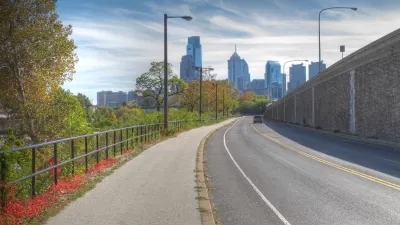It's been 21 years (and counting) since D.C. developed plans to build the Metropolitan Branch Trail's eight mile northern segment. The delayed project threatens the city's goal of increasing the proportion of biking and walking trips to 25 percent.
"Twenty-one years after plans were first devised -- and seven years after D.C.'s bike master plan called for its completion -- a planned eight mile bicycling and walking trail that may eventually connect Union Station and Silver Spring is still years away from being finished," reports Martin DiCaro.
Though the Metropolitan Branch Trail was the scene of an unprovoked attack this summer, it remains a popular bike route and a centerpiece of efforts to increase biking and walking mode share within the city.
"The issue is not money," explains DiCaro. "When construction eventually begins, DDOT has funding programmed into its budget to finish the eight-foot wide trail within Washington, whose completed southern segment (1.5 miles from Union Station to the Brookland neighborhood) sees 15,000 bicyclists and pedestrians per month. The biggest unresolved issue remains property conflicts near the Fort Totten Metro station: the Met Branch Trail must navigate a municipal trash transfer station, privately-owned railroad tracks and a concrete factory, onto National Park Service property and around land owned by Metro."
FULL STORY: First Envisioned 21 Years Ago, a D.C. Biking and Walking Path Remains Unfinished

Alabama: Trump Terminates Settlements for Black Communities Harmed By Raw Sewage
Trump deemed the landmark civil rights agreement “illegal DEI and environmental justice policy.”

Planetizen Federal Action Tracker
A weekly monitor of how Trump’s orders and actions are impacting planners and planning in America.

The 120 Year Old Tiny Home Villages That Sheltered San Francisco’s Earthquake Refugees
More than a century ago, San Francisco mobilized to house thousands of residents displaced by the 1906 earthquake. Could their strategy offer a model for the present?

In Both Crashes and Crime, Public Transportation is Far Safer than Driving
Contrary to popular assumptions, public transportation has far lower crash and crime rates than automobile travel. For safer communities, improve and encourage transit travel.

Report: Zoning Reforms Should Complement Nashville’s Ambitious Transit Plan
Without reform, restrictive zoning codes will limit the impact of the city’s planned transit expansion and could exclude some of the residents who depend on transit the most.

Judge Orders Release of Frozen IRA, IIJA Funding
The decision is a victory for environmental groups who charged that freezing funds for critical infrastructure and disaster response programs caused “real and irreparable harm” to communities.
Urban Design for Planners 1: Software Tools
This six-course series explores essential urban design concepts using open source software and equips planners with the tools they need to participate fully in the urban design process.
Planning for Universal Design
Learn the tools for implementing Universal Design in planning regulations.
Clanton & Associates, Inc.
Jessamine County Fiscal Court
Institute for Housing and Urban Development Studies (IHS)
City of Grandview
Harvard GSD Executive Education
Toledo-Lucas County Plan Commissions
Salt Lake City
NYU Wagner Graduate School of Public Service




























